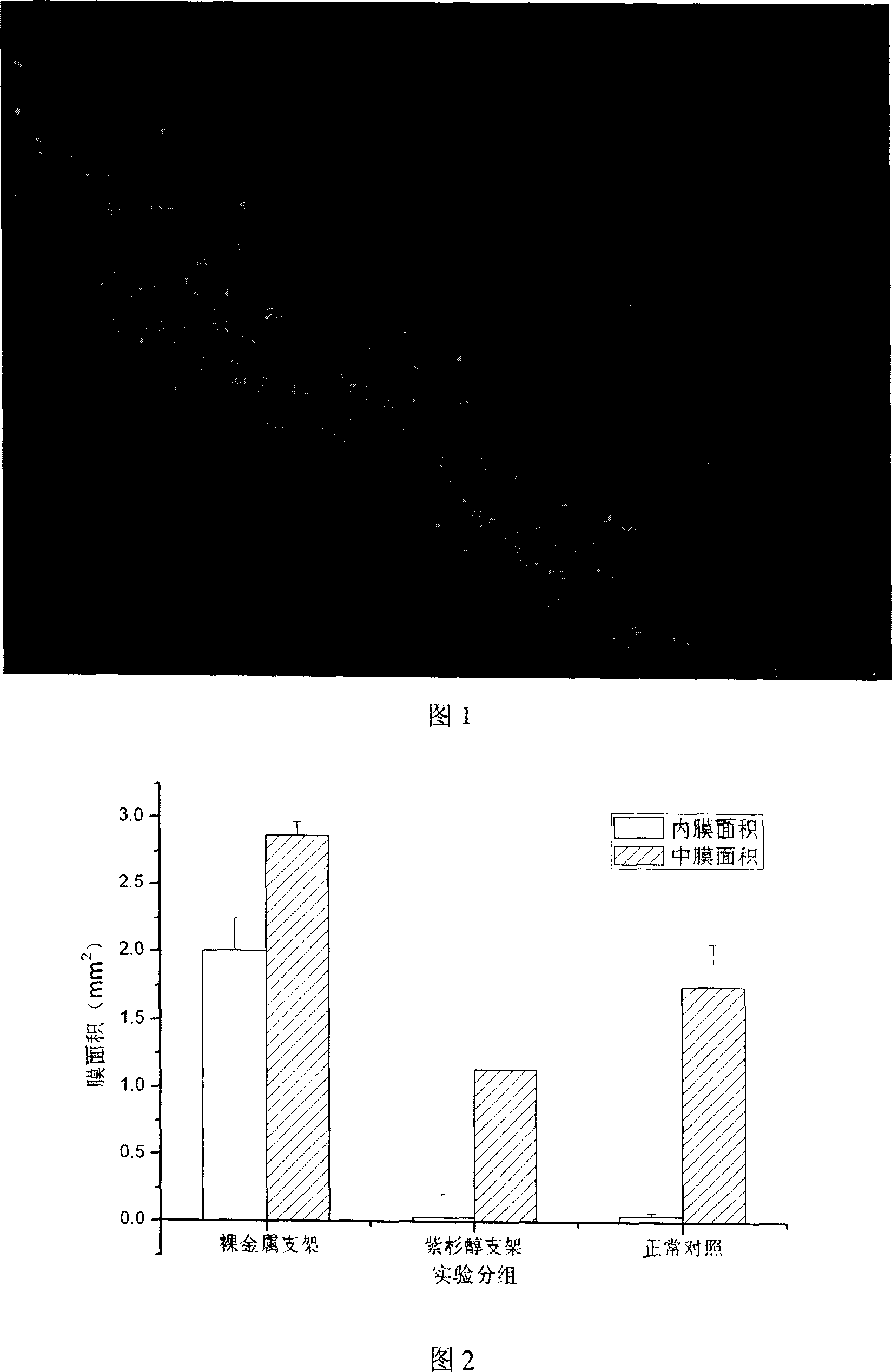Method for preparing drug or gene carried stent
A gene and drug-loading technology, which is applied in the field of medical materials, can solve the problem that the collagen coating is easily eluted, and achieve the effects of reducing toxicity and immunogenicity, improving transfection efficiency, and increasing drug loading
- Summary
- Abstract
- Description
- Claims
- Application Information
AI Technical Summary
Problems solved by technology
Method used
Image
Examples
Embodiment 1
[0034] Embodiment 1 A method for preparing a gene-carrying scaffold, consisting of the following steps:
[0035] (1) Pretreatment of the surface of the bracket
[0036] ① Soak the stent in acetone solution for 30 minutes and ultrasonically clean it for 30 minutes, then use isopropanol solution for ultrasonic cleaning for 30 minutes. Put into oven and dry for subsequent use, sputter 20nm chromium and the metal film of sputtering 50nm gold on the support after drying;
[0037] ② Fixing polymer: Soak the bare gold stent in 0.1M 11-mercaptoundecanol (dissolve 11-mercaptoundecanol in ethanol first, then water, dissolve in 80:20 ethanol and water) for 30 minutes , to form a single-layer self-assembled film on the gold film, rinse with distilled water; then put into 0.6M epichlorohydrin (dissolved in a 1:1 mixed solution of diglyme and 0.4M NaOH) to react 30 minutes, then rinse with water, ethanol, and water once; take it out and then put it into a 0.3g / ml dextran aqueous solution ...
Embodiment 2
[0046] Embodiment 2 A method for preparing a gene-carrying scaffold, consisting of the following steps:
[0047] (1) with embodiment 1;
[0048] (2) Solidification of gene molecules on the surface of the scaffold
[0049] a. Scaffold surface activation: put the fixed polymer scaffold into a mixed aqueous solution of 0.01M N-hydroxysuccinimide and 0.01M ethyl-dimethylaminopropyl-carbodiimide for 1 minute to Activate the scaffold surface;
[0050] b. Immobilization: put the surface-activated stent into a 1000g / L chitosan (carrier) aqueous solution with a pH of 3.6 and soak for 60 minutes, take it out, and put it into a 0.01M ethanolamine hydrochloride aqueous solution with a pH of 9 and soak for 30 minutes. blocking activation group;
[0051] c. Put 0.001g / L gene solution to be loaded and 0.001g / L Lipofectamine TM Soak in the mixed solution of 2000 ℃ for 30 minutes, the gene solution is that the gene is dissolved in the PBS solution that pH is 8 to make, and the Lipofectamin...
Embodiment 3
[0054] Embodiment 3 A method for preparing a gene-carrying scaffold, consisting of the following steps:
[0055] (1) with embodiment 1;
[0056] (2) Solidification of gene molecules on the surface of the scaffold
[0057] a. Scaffold surface activation: soak the fixed polymer scaffold in a mixed aqueous solution of 10M N-hydroxysuccinimide and 10M ethyl-dimethylaminopropyl-carbodiimide for 60 minutes to activate the scaffold surface;
[0058] b. Immobilization: put the surface-activated stent into a 0.1g / L chitosan (carrier) aqueous solution with a pH of 9 and soak for 5 minutes, take it out, and put it into a 10M ethanolamine hydrochloride aqueous solution with a pH of 8 and soak for 1 minute. blocking activation group;
[0059] c. Put 1g / L gene solution to be loaded and 1g / L Lipofectamine TM Soak for 120 minutes in the mixed solution of 2000, and described gene solution is that gene is dissolved in the PBS solution that pH is 5 to make, and described Lipofectamine TM 20...
PUM
 Login to View More
Login to View More Abstract
Description
Claims
Application Information
 Login to View More
Login to View More - R&D
- Intellectual Property
- Life Sciences
- Materials
- Tech Scout
- Unparalleled Data Quality
- Higher Quality Content
- 60% Fewer Hallucinations
Browse by: Latest US Patents, China's latest patents, Technical Efficacy Thesaurus, Application Domain, Technology Topic, Popular Technical Reports.
© 2025 PatSnap. All rights reserved.Legal|Privacy policy|Modern Slavery Act Transparency Statement|Sitemap|About US| Contact US: help@patsnap.com

